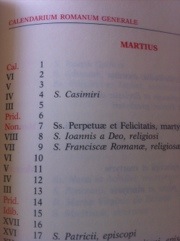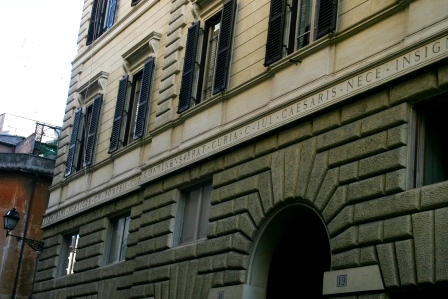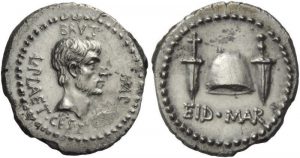 We call today the Ides of March, made especially famous in the English speaking world by Shakespeare in his play Julius Caesar.
We call today the Ides of March, made especially famous in the English speaking world by Shakespeare in his play Julius Caesar.
Caesar:
Who is it in the press that calls on me?
I hear a tongue shriller than all the music
Cry “Caesar!” Speak, Caesar is turn’d to hear.Soothsayer:
Beware the ides of March.Caesar:
What man is that?Brutus:
A soothsayer bids you beware the ides of March.
QUAERITUR: If someone were to ask you today “What are Ides?”, could you give an explanation?
Romans had three special days each month which were supposed to relate to the cycles of the moon. The first days of the month were the Kalends. Kalends gives us our word “calendar”, of course. The origin of this strange Latin word, with a K, is fuzzy. K in Latin immediately makes us suspect that there is something very ancient going on or perhaps something Greek. In this case, some think that Kalends comes from an announcement about the New Moon made to Juno on the Capitoline Hill, “kalo Iuno Novella… I call you, New Juno”. Who knows. Going on, the Nones fell either on the 5th in short months or 7th in longer months. The Ides fell either on the 13th or the 15th, depending on the month. Romans thought even numbered days were unlucky, so they jumped over them and didn’t hold religious events on them. Romans counted dates of the month backwards from these three days. Today, 15 March, is the Ides of March, tomorrow will be “ante diem xvii Kalendas Apriles… 17 days before the Kalends of April”.
Don’t worry that that doesn’t seem to add up. Romans counted days a little differently than we do.
 Here is a mnemonic poem to help remember when the Ides and other days fall in a month. It varies. This is from Gildersleeve’s Latin Grammar reworked by Lodge or what we call “Gildersleeve & Lodge” (my preferred grammar – UK HERE):
Here is a mnemonic poem to help remember when the Ides and other days fall in a month. It varies. This is from Gildersleeve’s Latin Grammar reworked by Lodge or what we call “Gildersleeve & Lodge” (my preferred grammar – UK HERE):
“In March, July, October, May,
The Ides are on the fifteenth day,
The Nones the seventh; but all besides
Have two days less for Nones and Ides.”
English “Ides” is from Latin Idus (always plural feminine) comes probably from Etruscan iduo, “to divide”, and thus it indicates that we are roughly at mid-month. However, there is a Sanskrit root indu which is “moon”, hence, the Idus are when the Roman thought the full moon ought to be (whether it was full or not, apparently).
You students of Latin need to know that in Latin the names of months are actually adjectives. In Latin we say that today is “the March-ian (month’s) Ides” or Idus Martiae (mensis). But in Latin we also conceive that the whole date is a single word or term. Thus, if we were going to put off something until, exempli gratia, 18 March we would say “differimus aliquid in ante diem xv Kal. April.”
Interesting, no? Nisi fallor, Romans paid interest on loans on the Ides.
Caesar sure paid.
 Anyway, we Catholics still pay attention to the ancient Roman way of calculating time. In the Latin edition of the Liturgy of the Hours (not the pre-Conciliar Roman Breviary) in the calendar section we still see indications of the ancient Roman dates.
Anyway, we Catholics still pay attention to the ancient Roman way of calculating time. In the Latin edition of the Liturgy of the Hours (not the pre-Conciliar Roman Breviary) in the calendar section we still see indications of the ancient Roman dates.
So, today is famously the day upon which Julius Caesar was assassinated.
Caesar had, apparently, been warned by various people, including his wife Calpurnia who had had a portentous dream, not to go to the Senate meeting that day. He went. He was killed with 23 stab wounds in the portico of the Theatre of Pompey.
Caesar was killed during a meeting of the Senate, but not in the Senate building.
 Pompey the Great, when he returned to Rome from Spain, still held power of imperium (to lead troops, etc.) and he could not legally cross the City limits (pomerium) without losing that power. So, in order to attend Senate meetings, he built a meeting hall for the Senate outside the pomerium. It was part of the complex of the palace and stone theatre he built, Rome’s first permanent stone theatre.
Pompey the Great, when he returned to Rome from Spain, still held power of imperium (to lead troops, etc.) and he could not legally cross the City limits (pomerium) without losing that power. So, in order to attend Senate meetings, he built a meeting hall for the Senate outside the pomerium. It was part of the complex of the palace and stone theatre he built, Rome’s first permanent stone theatre.
At this point there was no Senate building in the Roman Forum. The Senate had burned down after the murder of one of Caesar’s thugs Publius Clodius Pulcher by a guy named Milo. Milo was a creature aligned with Cicero and the optimates. Publius’s supporters brought his body to the Senate House (the Curia Cornelia which Lucius Cornelius Sulla had built to replace to old Curia Hostilia), and burned it there. They went into the Senate and hauled out the wooden furniture to burn the body. The Senate caught fire too and burned down. Caesar started the construction of a new Senate House, the Curia Iulia which stands still in the Forum because in the 7th century it was turned into a church, Sant’Adriano al Foro.
In the meantime, with the destruction of the curia (still today the technical name for a diocesan chancery) the Senate moved around, meeting in temples or often at the aforementioned hall built by Pompey.
PERSONAL ANECDOTE:
The main door of my seminary in Rome opened onto the street which corresponds, according to clever German archeologists, to the place Caesar was slain by Brutus and the other conspirators, the end of the square shaped portico of Pompey’s Theatre complex.

In my first year in my Roman seminary, I could look out my window and see the curving facade of a large building constructed on the curved remains of Pompey’s theatre. Thus the Via del Monte della Farina, along the side of the Church Sant’Andrea della Valle, where the 1st Act of Pucinin’s Tosca takes place and where the fascinating humanist Pope Pius II is interred, runs just where Pompey’s senate meeting hall was. That’s where Caesar was killed.
[As it turns out, better scholarship revealed that Caesar was killed where the edge of the “dig” of the Largo Argentina is.]
Also, one of my favorite restaurants in Rome has visible traces of Pompey’s complex… no, not the “famous” restaurant. The one I mean is far better.
So, the notion that Caesar was killed under a statue of Pompey, whom Caesar had double-crossed and effectively bumped off (he was killed in Egypt and his body sent back to Rome pickled in a butt of wine), isn’t far off the mark. There is an inscription on a building on the Via del Monte della Farina to mark the spot of Caesar’s demise. [The Germans were close, but they missed the mark. See red comments, above.]
“Publius”, by the way, was the nom de plume used by James Madison, Alexander Hamilton and John Jay in The Federalist Papers. In the rebuttals written to the Federalist Papers, the Anti-Federalist Papers on the of the writers is… yes… you guessed it… “Brutus”.
 For those of you who are interested in coins, there is a super rare ancient Roman coin that is marked with “the Ides of March”. There are only 75 of them known in the world right now.
For those of you who are interested in coins, there is a super rare ancient Roman coin that is marked with “the Ides of March”. There are only 75 of them known in the world right now.
On the reverse of the coin (the right in the picture) you see EID MAR, “the Ides of March”. This coin was struck by Brutus and company when they fled with an army to Greece in 42 BC a couple months before they were defeated at the Philippi. The obverse of the coin (left) declares that Brutus, whose profile you see, was “IMP(ERATOR)” of his little freedom-fighter army. The reverse has daggers. You know what those are all about. The upside-down cup-like thing is a pileus, an Eastern-style “Phrygian cap”, which was worn by freed slaves.
One of the things that a master did when he freed or “manumitted” a slave (“manus mittere” a symbolic placing of one’s hand on a slave as a sign of freeing him) is place this sort of cap on the slave’s shaved head. Therefore, this lumpy cap became a symbol of freedom.
Coins are designed to communicate messages. The ancient Roman coin above says that Brutus, et alii, freed the Roman people from slavery by killing Caesar and that Brutus is a legitimate guy because his army acclaimed him to be their imperator, yadda yadda.
 That pileus, the Phrygian cap, has through the centuries become a symbol of freedom from tyranny and for revolution.
That pileus, the Phrygian cap, has through the centuries become a symbol of freedom from tyranny and for revolution.
In the Terror commonly called the French Revolution (“revolution” in Latin in res novae, “new things”, which were always bad in the eyes of Romans… and Leo XIII’s famous encyclical begins, “Rerum novarum semel excitata cupidine…”… Latin novus carries, always, a bad connotation), the Phygian cap was popular.
This cap appears on coats-of arms and flags of nations. Once you know what it is, you start seeing it – if not everywhere – all over the place.
The Phrygian cap is on the seal of the  US Senate.
US Senate.
And let us not forget, or let us learn for the first, time, that a zucchetto, white for popes, porpora sacra for cardinals, paonazza for bishops and black for priests, is, in Latin, pileus. It’s the same Latin word but different idea… in most cases. There are some bishops who are terrorist revolutionaries… but I digress. The zucchetto is great for keeping one’s shaved tonsure or bald spot, take your pick, warm.
As a matter of fact, I associate the bishop’s zucchetto with the Pauline eudoxia, or “authority”… the veil that women are to wear, a sign of submission, yes, but ultimately of true freedom.
WARNING! THEOLOGICAL DIGRESSION ON CHAPEL VEILS: Consider that Paul tells the Corinthians that men are to pray with head uncovered (because they are images of the Father revealing action and gift) while women are pray with heads covered (because they image the glory of man revealing receptivity and submission). The two, equal in dignity, reveal a complementarity. This equal complementarity is manifested in clothing. However, you might object, Jewish men in Paul’s time did pray with their head’s covered. But, I respond, not when sacrificing. The soul is described in feminine terms by virtually all writers, and, true enough, the soul must be receptive and submissive to the gifts of God. Hence, males cover their heads at times. But in key moments of the liturgical action, they uncover their heads to show how they are “imaging” the action and transcendence of the Father. The bishop’s zucchetto is removed as the Canon begins, the most clearly sacrificial part of the Mass. But I digress.
Back to the coin.
There so few of these Brutus EID MAR coins around because Marcus Antonius and Gaius Octavius (later called Augustus – born, by the way, in Velletri, a town I have a connection to and lived in for some time) had them all, with their bad message, melted down. This was a kind of damnatio memoriae, an attempt to obliterate the even the memory of a person or thing.
Sometimes there was an official damnatio memoriae issued by the Senate. In Rome today you can see on ancient monuments where one guy’s name was carved out of the marble and another guy’s name was carved in its place. A great example of this is on the Arch of Septimius Severus near the Curia Iulia in the Roman Forum. When Caracalla had Geta bumped of in 212 he had all references to Geta extirpated from the Arch.
 In more modern times, still in Rome, the name of Mussolini was obliterated from nearly every building of his period. Near the Mausoleum of Augustus, for example, there was a raised inscription of Latin dactylic hexameters about the shades of the emperors flying about the place and the name of Mussolini (who had cleared the area and set up the Ara Pacis nearby) was covered over in concrete. Over the years the concrete has eroded away and you can see il Duce’s name once again. We need these reminders!
In more modern times, still in Rome, the name of Mussolini was obliterated from nearly every building of his period. Near the Mausoleum of Augustus, for example, there was a raised inscription of Latin dactylic hexameters about the shades of the emperors flying about the place and the name of Mussolini (who had cleared the area and set up the Ara Pacis nearby) was covered over in concrete. Over the years the concrete has eroded away and you can see il Duce’s name once again. We need these reminders!
But one way to deal with a person or a thing you don’t care for is never to mention it by name. I, as a matter of fact, avoid mention of some things – or websites – all the time.
 In ancient times, and even in more modern times, mentioning a thing or person’s name was thought to be an almost magical act, onomancy, which could summon. Names were sometimes considered influential in determining one’s destiny, a kind of nominative determinism: Nomen omen…
In ancient times, and even in more modern times, mentioning a thing or person’s name was thought to be an almost magical act, onomancy, which could summon. Names were sometimes considered influential in determining one’s destiny, a kind of nominative determinism: Nomen omen…
Speaking of the “reverse” of the rarely-preserved Brutus coin, in the Patrick O’Brien book Reverse of the Medal there is this exchange:
‘You may say what you like, Barret Bonden,’ said Plaice, ‘but I’m older than you, and I say this here barky’s got what we call a…’
‘Easy, Joe,’ said Killick. ‘Naming calls, you know.”
‘What?’ asked Joe Plaice, who was rather deaf.
‘Naming calls, Joe,’ said Killick, laying his finger to his lips.
Bonden was Capt. Aubrey’s coxswain (pronounced “coxson”) and Preserved Killick his steward. Joe Plaice once obtained a depressed fracture of the skull during combat and Dr. Stephen Maturin, having trapanned him, covered the round hole with a hammered out coin. The scene is depicted in the movie. US HERE UK HERE
Not a Brutus EID MAR coin, however.
So, if questioned, can you now explain something about the Ides of March?
Meanwhile…



































On the Ides of March I can now explain a bit, but I’m not sure about the day after the Ides of March. Thank you, that is so interesting.
It’s interesting that in most months the Ides fell on the 13th rather than the 15th. The events of March 13, 2013, offer a strong argument that that date was one to beware.
Two things:
1) Every latinist and Caesar aficionado ought to own a copy of Karl Heinz Graf von Rothenburg’s incredible comic book rendering of the first chapter of the Gallic Wars “Caesaris Bellum Helveticum.” It is so cool.
2) But Brutus is an honourable man!
https://youtu.be/0bi1PvXCbr8 (Charlton Heston doing his finest Marc Anthony)
It’s a fine thing to call it “tyranny” when a man settles his veterans and leaves a huge chunk of his lands and wealth to the people of Rome, his people. I’ll pass on Brutus’ “liberty.”
Latin actually had three different “c” sounds, well Republican era Latin did anyway, though by the time of the Classical era they had become mostly confused.
The q was made at the back of the palate, and IIRC c in the middle, and k towards the front. The c/k were the first to become phonetically indistinguishable to the Latin ear, which led to k being rare in Latin spellings except in adapted Greek vocabulary.
In ancient times, and even in more modern times, mentioning a thing or person’s name was thought to be an almost magical act, onomancy, which could summon.
Obviously, there is a rather famous authoress who used that effect in great length in a popular fantasy series.
I found it a rather interesting observation how soon people three years ago started to resort to phrases like “for reasons we all know of”, etc.; even a conscious “the sickness that must not be named”, etc., was not altogether rare. I don’t believe it was superstition, more a case of being generally fed up with the thing, but apparently we don’t like to pronounce a thing we’re fed up with.
[Is that the Ursula LeGuin (sp?) series?]
Would that be Da Prancazio? [No, that’s the “famous one” which I do NOT favor. There is another, better place nearby.]
One other interesting thing is the E in EID MAR.
It is known that IDUS once was EIDUS, like IRE was EIRE which is where we get eo, is, it, imus, itis, eunt from. But this was the year 44 BC: Caesar was already dead, so it sure is past De bello Gallico. Also, the bulk of the work of Cicero had already been written, as had been the poems of Catullus, and, I believe, also De coniuratione Catilinae: Sallust often uses old forms, but never the old EIs and OIs to my knowledge. And here, Brutus just goes and mints a coin using the language of, probably, at least 150 years past? Interesting.
Oh, what a delightful read! Thank you Father!
It’s a shame people don’t respect the spirit of the day properly. It’s not just about stabbing people. It’s about coming together as a community to stab people.
[Ah yes, that one is evergreen!]
Then could you tell us the name of the restaurant you do favour, please? I am off to Rome for a little holiday soon, staying at a lovely hotel run by some well-known nuns, close to the English College. I would love to try it, based on your recommendation. Many Thanks.
@Imrahil
“And here, Brutus just goes and mints a coin using the language of, probably, at least 150 years past? Interesting.”
Probably a reference to republican times, but it is of note that deliberate antiquarianism crops up during the early empire under Augustus.
(Also, the latin texts we have now passed through centuries of handwriting, and scribes had a tendency to standardize spelling)
I was confused what “glory” meant until I read in some social sciences analyses of Scripture that it basically means “honor” and that in ancient mediterranean/near east honor culture women are relevant to male honor. So is the idea that women through submission enhance their men’s honor? This is a logical concept but it’s arguably different from simple complementarity. According to the social sciences theorists, females embody a positive characteristic of shame which does not need to be morbid shame but rather a modesty and submissiveness, and this shame is the female form of honor; females have honor in this system so long as they have appropriate shame. Is there something to this or how do you see it differently than the social sciences exegetes?
But Father, shouldn’t there be like 9 or 15 stab wounds in caesar? Or was that Brutus’ initial plunge?
Quoting myself, sorry :
“Latin actually had three different “c” sounds, well Republican era Latin did anyway, though by the time of the Classical era they had become mostly confused.”
Actually, one example of a survival in Classical Latin of different pronunciation is in cui vs. qui. Not Late, Biblical, nor Church Latin — but Classical, yes.